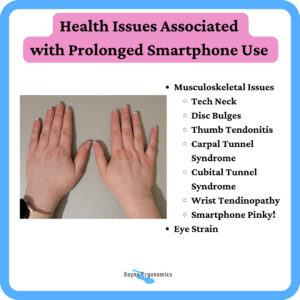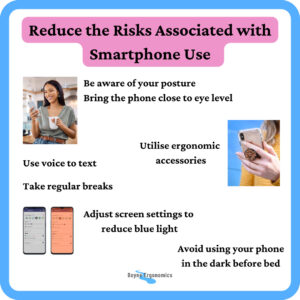In the fast-paced world we live in, smartphones have become an integral part of our daily lives.
As per Statista, there will be over 4 billion smartphone users in 2024, increasing to over 6 billion in 2029. There is no doubt that smartphone use increased during the Covid lockdowns, as we looked for ways to stay connected and pass the time. Ratan et al (2021) reported that 70% of internet users, especially younger users, were using their smartphones more during the pandemic as a direct result of lockdowns. The same study reported that 61% of parents classified their children as addicted to their smart devices. From staying connected to using social media to managing work tasks on the go, our reliance on these devices is undeniable. However, the convenience of smartphones comes at a cost to our physical and psychological wellbeing. For the purposes of this blog post, I will be focusing on musculoskeletal discomfort and eye strain.
There have been many studies linking smartphone use to musculoskeletal discomfort, reduced quality of sleep and poor psychological well being.
Jacquier-Bret & Gorse (2023) reported that between 50% – 84% of smartphone users report musculoskeletal disorders.
Sirajudeen et al (2022) reported that smartphone addiction and overuse are associated with musculoskeletal disorders (MSDs), mostly affecting the neck (55.8% to 89.9%), followed by the shoulders (37.8% to 71.6%), hands/wrists (13% to 32%), and elbows (14.1% to 15%), among university students and general users.
Rafique et al (2020) found that users that looked at the phone screen ≥8 hours/24 hours, used the phone for at least 30 minutes before sleeping after the lights had been turned off and kept the phone near the pillow reported poor sleep quality.
In this blog post, I explore the risks associated with smartphone use, the symptoms of excessive use and provide practical recommendations to mitigate potential long-term damage.
What Are the Ergonomic Risks Associated with Smartphone Use?
The ergonomic risk factors associated with smartphone use are adverse or awkward postures, prolonged static postures, repetitive stress, grip forces and blue light emission.
Adverse or Awkward Postures:
Ever catch a glimpse of yourself when using your phone? Or look around the bus or train at others? What do you notice? Head down and shoulders rounded. This posture, with the head forward from the midline, increases the workload on the neck, shoulder and upper back muscles, strains the ligaments and compresses the cervical discs.
Aside from the head down posture, when we are scrolling through the smartphone we often see people adopting postures that increase strain on the lower back, such as slouching, leaning, twisted torso, shoulder resting on the arm of a chair, arms away from the body etc.
I am a believer that there is no wrong posture, after all we are made to be mobile in a range of directions. However, prolonged static positioning with the joints beyond their mid point, or frequent movement of the joints without adequate breaks can increase the risk of strain, discomfort and injury.
Prolonged Static Postures:
It has happened to us all, we get caught down a scroll hole and before we know it 20 minutes have passed and we feel stiff and tight in the neck, shoulders and back.
Static postures cause a build up of waste products and reduced circulation of fuel and oxygen to the muscles, causing them to get fatigued, stiff and inflamed.
Repetitive Movements:
Whether scrolling or typing, smartphone use usually involves repetitive movements of the thumbs, fingers, wrists, elbow and neck.
When muscles and tendons are worked, tiny micro tears can form in the tissues. Inflammation occurs in the area as the body works to repair the tissues.
However, if this is repeated without appropriate recovery periods, the inflammation worsens, scar tissue develops and pain can follow.
Grip Forces:
Smartphone size usually requires them to be held in a wide finger grip so stop them from falling from our hands. This increases the workload on the forearm and hand holding the phone.
Blue Light Emission:
High energy short wave blue light from digital screens can have a negative impact on the health of the cornea, lens and retina of the eye. They have also been found to negatively impact sleep quality.

What Are the Symptoms of Not So Smart Use of Smartphones?
Musculoskeletal Issues:
Muscle inflammation, tendonitis, joint inflammation, ligament strain, tendinopathy and nerve irritation are risks associated with frequent and prolonged use of smartphones.
Postural syndrome of the neck, mid and lower back is the discomfort that we feel in the muscles when we are in awkward or strained postures. You will notice a dull ache in the area if you spend prolonged periods in a certain position, such as aches in the neck, upper back and shoulders when you look down at your phone, or in your lower back when you slouch or slide forward in a seat.
Tech neck is the term used to describe The common symptoms are stiffness and an aching discomfort in the neck, shoulders and upper back, headaches, decreased range of movement in the neck, intense stabbing pain in the neck or shoulder, pain in neck when looking down, jaw pain, tingling and numbness in the arm or hands. For more information on Tech Neck check out my blog post https://boyneergonomics.ie/what-is-tech-neck-and-how-to-prevent-it/
Disc bulges in the spine, particularly in the neck and lower back can be caused by prolonged and frequent poor postures, including bending, slouching, lifting and twisting.
Thumb Tendonitis, also known as De Quervains Tendonitis, is caused by the overuse of the thumb. Repetitive and prolonged use of the thumbs cause the tendons to become inflamed.
Carpal Tunnel Syndrome is caused when the flexor tendons going from the forearm to the hand via the carpal tunnel in the wrist, become inflamed / damaged and compress the median nerve.
Wrist tendinopathy occurs mainly via overuse of the tendons of the wrist. This can cause degeneration of the collagen and thinning / disorientation of the fibers.
Cubital Tunnel Syndrome is caused by compression of the ulnar nerve at the elbow.
Smartphone pinky! Yes, that is the official term! I have recently noticed that when I rest or relax my hands, the pinky on the right hand is resting away from the adjacent ring finger. This is actually what has spurred this blog post. I use my smartphone for some of onsite assessments and I noticed that I place my right pinky under my phone to stabilise it when completing my forms in my app!
Digital Eye Strain:
As per a previous blog post (https://boyneergonomics.ie/are-you-suffering-from-digital-eye-strain/) Digital Eye Strain (DES), also known as Computer Vision Syndrome, is the umbrella term given to the ocular and non ocular symptoms associated with prolonged use of digital screens. Symptoms include dry eyes, headaches, and blurred vision.
Increased visual demands, reduced blinking rate, screen distance, brightness, glare and blue light emission are some of the factors associated with smartphone use that can negatively impact the eyes and vision.

Recommendations for Smart use of your Smartphone
Reduce Adverse Postures:
Be conscious of your posture. Hold your phone at eye level whenever possible to reduce strain on the neck.
Sit up straight and avoid slouching while using your phone.
Use supportive cushions to maintain a healthy posture.
Practice hand and finger stretches to maintain flexibility and reduce strain.
Consider using ergonomic accessories like pop sockets, styluses or ergonomic keyboards to minimize strain.
Be mindful of the time spent on your mobile phone. Set limits and take breaks to reduce the risk of both visual and musculoskeletal strain.
Reduce Repetitive Movements:
Take regular breaks to stretch your neck, shoulders, hands and wrists.
Use voice-to-text features when possible to reduce the need for constant typing.
Reduce Grip Forces
Take regular breaks to stretch your hands and wrists.
Consider using ergonomic accessories like pop sockets or other phone accessories that make it easier to hold the phone.
Phone stands should be used where possible to reduce the need to hold the phone.
Reduce Eye Strain:
Customize your phone settings for optimal comfort. Adjust the font size, brightness, and contrast to reduce eye strain.
Implement the 20-20-20 rule – take a 20-second break every 20 minutes and look at something 20 feet away.
Consider using blue light filters on your phone or wearing blue light-blocking glasses to reduce eye strain.
Avoid using your smartphone in bed, particularly when the room is dark.

While smartphones are now essential in our modern lives, it’s crucial to use them responsibly to protect our visual and musculoskeletal health. By incorporating these recommendations into your daily routine, you can enjoy the benefits of technology without compromising your well-being. Remember, a proactive approach to ergonomics is the key to long-term health and comfort.
Sources:
Jacquier-Bret & Gorse (2023) Effect of day time on smartphone use posture and related musculoskeletal disorder risk: a survey among university students. BMC Musculoskeletal Disorders. https://bmcmusculoskeletdisord.biomedcentral.com/articles/10.1186/
Rafique et al (2020) Effects of mobile use on subjective sleep quality. Nat Sci Sleep. https://www.ncbi.nlm.nih.gov/pmc/articles/PMC7320888/
Ratan et al (2021) Smartphone overuse: A hidden crisis in Covid 19. Health Policy Technology. https://www.ncbi.nlm.nih.gov/pmc/articles/PMC7825859/
Sirajudeen et al (2022) Prevalence of Upper Limb Musculoskeletal Disorders and Their Association with Smartphone Addiction and Smartphone Usage among University Students in the Kingdom of Saudi Arabia during the COVID-19 Pandemic—A Cross-Sectional Study. Healthcare Basel. https://www.ncbi.nlm.nih.gov/pmc/articles/PMC9777717/
Stoffregen, T. (Editor) (2018) Ergonomic risk assessment of smartphone users using the Rapid Upper Limb Assessment (RULA) tool. PLoS One https://www.ncbi.nlm.nih.gov/pmc/articles/PMC6117073/
https://www.statista.com/forecasts/1143723/smartphone-users-in-the-world


